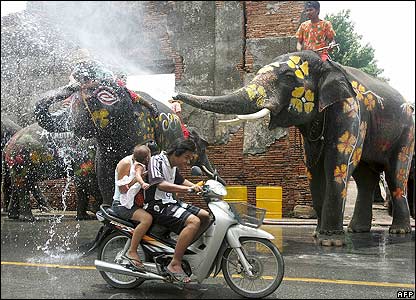View Touring Around Pak in a larger map
Here we want to present you a tour started from our guest house, Pak Chiang Mai. This is a walking trip to see famous temples and landmark inside the moat area of Chiang Mai. You'll get to see 11 temples and one historical landmark so you might have to planned on what temple you'd like to stop by because if you want to visit them all, it might take more time than you expected.
Just by walking along on this path we created might take about an hour to finish. We have create a must list for you to make sure you won't miss the most spectacular building around this path.
Start from Pak Chiang Mai, the nearest stop that you could take is just like 20 metres far. Phor liang Meun Pottery is the first place you could visit. This place holds a lot of Buddha statues and Chiang Mai traditional style pottery.
Now the next important stop would be Wat Chedi Luang, a giant pagoda with it's top collapsed by the force of earthquake during 1545AC. There are 3 temples on the road before you'd hit Wat Chedi Luang, which are Wat Fon Soi, Wat Ched Lin, and Wat Chang Taem. Drop by on whichever you feels like.
The next stop will be an area around the Three Kings Monument. You can find something to eat around here as well as something to take a photo with as well. Wat Inthakin, Wat Duang Dee, and Wat Phan Tao are your choices to visit.
As you go along the road to Wat Pra Singha, which is the next big stop, you can visit Wat Pha Bong, which located right at the intersection. Note that Wat Pra Singha is as big as Wat Chedi Luang and could take some of your time on photographing.
And Now you may finally head back to Pak Chiang Mai. There are 2 temples left for you to visit if you'd like to, which are Wat Pra Chao Meng Rai and Wat Phan Waen. There is also a good restaurant located at the trisection before Wat Pra Chao Meng Rai called Huen Phen Restaurant if you'd like to try out their food.
So decide your own stop! The length of this tour mainly based on how many temples you visited and how long you'd spend time with.
Just by walking along on this path we created might take about an hour to finish. We have create a must list for you to make sure you won't miss the most spectacular building around this path.
Start from Pak Chiang Mai, the nearest stop that you could take is just like 20 metres far. Phor liang Meun Pottery is the first place you could visit. This place holds a lot of Buddha statues and Chiang Mai traditional style pottery.
Now the next important stop would be Wat Chedi Luang, a giant pagoda with it's top collapsed by the force of earthquake during 1545AC. There are 3 temples on the road before you'd hit Wat Chedi Luang, which are Wat Fon Soi, Wat Ched Lin, and Wat Chang Taem. Drop by on whichever you feels like.
The next stop will be an area around the Three Kings Monument. You can find something to eat around here as well as something to take a photo with as well. Wat Inthakin, Wat Duang Dee, and Wat Phan Tao are your choices to visit.
As you go along the road to Wat Pra Singha, which is the next big stop, you can visit Wat Pha Bong, which located right at the intersection. Note that Wat Pra Singha is as big as Wat Chedi Luang and could take some of your time on photographing.
And Now you may finally head back to Pak Chiang Mai. There are 2 temples left for you to visit if you'd like to, which are Wat Pra Chao Meng Rai and Wat Phan Waen. There is also a good restaurant located at the trisection before Wat Pra Chao Meng Rai called Huen Phen Restaurant if you'd like to try out their food.
So decide your own stop! The length of this tour mainly based on how many temples you visited and how long you'd spend time with.

















